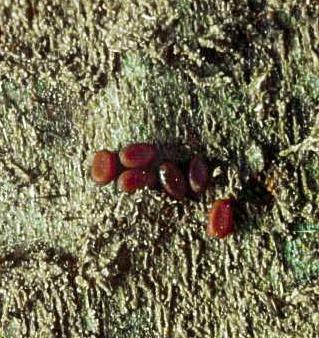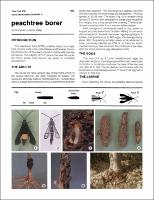peach tree borer life cycle
The pupal stage can last 18 to 30 days after which adults emerge and mate. When mature the larva constructs a cocoon under the bark at or near soil level and pupates.

Peach Tree Borer Fairfax Gardening
Adult moths of the lesser peachtree borer emerge from late May through September while peachtree borers emerge from midJune to early September.

. Biology The adult beetle is about 05 to 1 inch long with the antennae being about the same length. In the spring feeding is resumed and the larval period is completed. Capnodis tenebrionis Peach root borer Stone-fruit trees Instar Sex ratio.
The peach tree borer completes one life cycle a year. Only the immature larva stage Figure 3 produces the damage to trees. By peachtree borer Life History and Habits The life cycle of the peachtree borer requires one year to complete.
Lesser peach tree borers attack higher on the trunk and scaffold branches especially where there are injuries and callus tissue. The larvae are up to 16 mm long with a dark brown to reddish brown body paler. The eggs hatch in 10-14 days and the larvae immediately seek places for gaining entrance into the tree.
Upon hatching from the eggs Figure 4 young larvae immediately tunnel into the sapwood of the tre. Only the immature larva stage Figure 3 produces the damage to trees. The lesser borer completes about one and one-half cycles a year.
Peachtree Borer eggs are oval reddish-brown and are deposited singly or in small groups on the trunk. Infested trees may yellow and eventually die as the larvae girdle the tree at the crown. Peach tree borers attack near the soil line with most activity occurring a few inches 5 to 75 cm below the ground.
The adult peachtree borer is a clear wing moth with a 1-14 wing span. Borer damage is usually attended by gumming with varying amounts of frass in the gum. The adult borer emerges in the late spring and early summer.
Some peachtree borers may feed for two seasons before completing their life cycle development but the majority require only one year. The larvae immediately crawl through cracks in the bark and begin tunneling and eating the inner bark cambium layer. This borer does not seem to distinguish between weak and healthy trees.
The peachtree borer moths lay eggs on the tree trunks and in debris near the base of the trunk. Upon hatching from the eggs Figure 4 young larvae immediately tunnel into the sapwood of the tree usually through by WS. Females laid eggs and the life cycle repeated.
How Peach Tree Borers Damage Trees. Most adults emerge and lay up to 500 eggs during July and August on tree trunks in cracks or under bark scales and in soil near the tree trunk. Damage Any wound on stone fruit trees may cause gum to exude.
Unlike most moths PTB are active during the day mostly between late morning and early afternoon Mated females deposit anywhere from 200 to 800 eggs near the bases of trees with eggs hatching in 9 to 10 days. Keep reading to learn more about how to control peach tree borers. Much of the United States including Texas and Nebraska has one generation per year.
The borer has a two-year life cycle. Much of the United States including Texas and Nebraska has one generation per year. Life Cycle Adults begin emerging in late spring and early summer from larvae that have overwintered inside the tree an inch or two beneath the soil line.
This native American borer has been known since colonial times and is a pest wherever peaches are grown. The adult peachtree borer is a steel blue to black moth that resembles a wasp. Hatching larvae tunnel into the tree at or slightly below ground level.
Peach borer larvae tunnel through cracks and wounds within bark feeding on the sapwood. Eggs hatch in mid-July and the larvae immediately start burrowing into the bark. It is reported that it takes two years to complete a life cycle in Canada and in a small percentage of populations in New York.
The eggs are elongate-oval about 03 x 05 mm in size and orange yellow. The clear-winged female moths lay their eggs on the bark at the base of tree trunks in mid- to late-summer. The body is entirely white except for three broad longitudinal brown stripes extending the full length of the body.
The period of time required to complete a life cycle varies considerably throughout the range of the peachtree borer. Results were discussed conclusions and recommendation were made. Tree Fruit Insect Pest - Peachtree Borer.
The peachtree borer overwinters as a partly grown larva in its burrow beneath the bark of the tree. The life cycle of the peachtree borer requires one year to complete. Life cycle and appearance of Peach twig borer.
Black knot galls found on cherry and plum are favorite attack sites. The peachtree borer overwinters as a partly grown larva in its burrow beneath the bark of the tree. It is reported that it takes two years to complete a life cycle in Canada and in a small percentage of populations in New York.
The moths have a wingspan of 12-16 mm with dark brown to greyish black forewings with irregular black markings and light brownish grey hindwings. Lesser peach tree borers have a life cycle very similar to that of peach tree borer but the timing and location of attack are slightly different. Life cycle of the peach tree borer The first eggs of the season hatch in mid-July about 10 days after they were laid on the lower trunk or nearby on the ground.
In the spring feeding is resumed and the larval period is completed. Life Cycle The period of time required to complete a life cycle varies considerably throughout the range of the peachtree borer. Unlike the majority of moths these fly during the day and are most active from 10 am.
The larvae feed on the cambium or growing tissue and tunnel between the inner bark and sapwood. The pests life cycle and treatment is similar to those of exitiosa. Life cycles of peachtree borers and lesser peachtree borers Winter is spent as a larva under the bark in the cambium layer.

Peachtree Borer 5 566 Extension

Peachtree Borer Nc State Extension Publications
Peachtree Borer Wsu Tree Fruit Washington State University
Apple Clearwing Moth Small Red Belted Clearing Moth
Pests Bc Tree Fruit Production Guide
Pests Bc Tree Fruit Production Guide
Pests Bc Tree Fruit Production Guide

Lesser Peachtree Borer Damage Stock Image C025 7085 Science Photo Library

Peach Tree Borer Treatment Control Planet Natural

Peachtree Borer Nc State Extension Publications

Lords Environmental Peach Tree Borers

Greater Peachtree Borer In The Landscape Nc State Extension Publications

Peach Tree Borer Trap Pest Control From Gardens Alive
Eny 691 In489 Peachtree Borers In The Home And Commercial Peach Orchard



